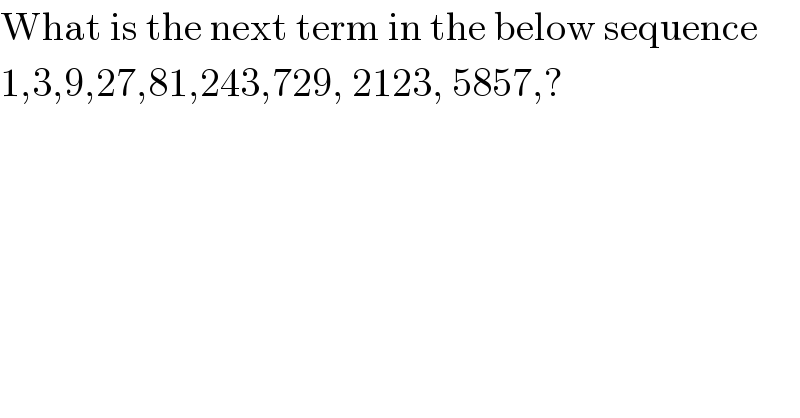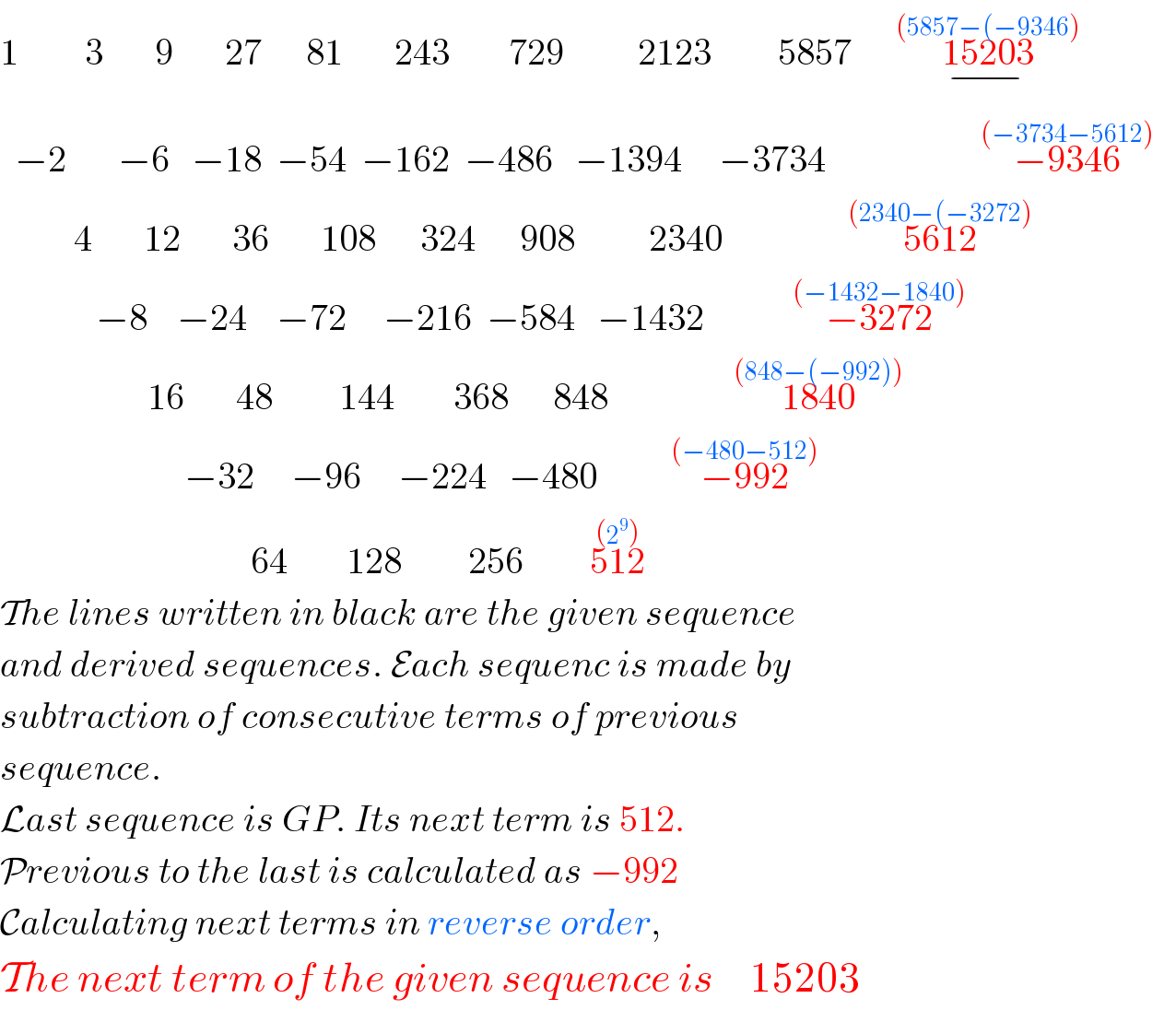
Question Number 3105 by prakash jain last updated on 04/Dec/15

$$\mathrm{What}\:\mathrm{is}\:\mathrm{the}\:\mathrm{next}\:\mathrm{term}\:\mathrm{in}\:\mathrm{the}\:\mathrm{below}\:\mathrm{sequence} \\ $$$$\mathrm{1},\mathrm{3},\mathrm{9},\mathrm{27},\mathrm{81},\mathrm{243},\mathrm{729},\:\mathrm{2123},\:\mathrm{5857},? \\ $$
Commented by Filup last updated on 04/Dec/15

$$\mathrm{3}^{\mathrm{10}} ? \\ $$
Commented by prakash jain last updated on 05/Dec/15

$$\mathrm{2123}\neq\mathrm{3}^{\mathrm{7}} \\ $$
Commented by Filup last updated on 05/Dec/15

$$\bar {\:}�\backslash\left(\:^{\bullet} −^{\bullet} \right)/\bar {\:}\bar {\:} \\ $$$$\mathrm{You}\:\mathrm{have}\:\mathrm{me}\:\mathrm{stumped}\:\mathrm{on}\:\mathrm{this}\:\mathrm{one}. \\ $$$$\mathrm{For}\:\mathrm{now}... \\ $$
Commented by prakash jain last updated on 05/Dec/15

$$\mathrm{I}\:\mathrm{was}\:\mathrm{trying}\:\mathrm{to}\:\mathrm{highlight}\:\mathrm{a}\:\mathrm{point}\:\mathrm{that}\:\mathrm{given} \\ $$$$\mathrm{a}\:\mathrm{finite}\:\mathrm{number}\:\mathrm{of}\:\mathrm{terms}\:\mathrm{there}\:\mathrm{are}\:\mathrm{infinite} \\ $$$$\mathrm{number}\:\mathrm{of}\:\mathrm{formula}\:\mathrm{that}\:\mathrm{can}\:\mathrm{be}\:\mathrm{defined}\:\mathrm{to} \\ $$$$\mathrm{generate}\:\mathrm{the}\:\mathrm{next}\:\mathrm{term}. \\ $$$$\mathrm{So}\:\mathrm{if}\:\mathrm{you}\:\mathrm{were}\:\mathrm{given}\:\mathrm{only}\:\mathrm{first}\:\mathrm{7}\:\mathrm{term}\:\mathrm{the}\: \\ $$$$\mathrm{obvious}\:\mathrm{formula}\:\mathrm{is}\:\mathrm{3}^{{n}−\mathrm{1}} ,\:\mathrm{while}\:\mathrm{there}\:\mathrm{may} \\ $$$$\mathrm{be}\:\mathrm{other}\:\mathrm{formulas}\:\mathrm{as}\:\mathrm{well}. \\ $$
Commented by Rasheed Soomro last updated on 05/Dec/15

$${You}\:{have}\:{answered}\:{my}\:{mind}\:'{s}\:{question}\:{before}\:{expressing}!! \\ $$
Commented by Rasheed Soomro last updated on 05/Dec/15

$$\:\:\:\:\mathrm{15203} \\ $$
Answered by Rasheed Soomro last updated on 06/Dec/15

$$\mathrm{1}\:\:\:\:\:\:\:\:\:\mathrm{3}\:\:\:\:\:\:\:\mathrm{9}\:\:\:\:\:\:\:\mathrm{27}\:\:\:\:\:\:\mathrm{81}\:\:\:\:\:\:\:\mathrm{243}\:\:\:\:\:\:\:\:\mathrm{729}\:\:\:\:\:\:\:\:\:\:\mathrm{2123}\:\:\:\:\:\:\:\:\:\mathrm{5857}\:\:\:\:\:\:\underset{−} {\overset{\left(\mathrm{5857}−\left(−\mathrm{9346}\right)\right.} {\mathrm{15203}}}\:\:\: \\ $$$$\:\:−\mathrm{2}\:\:\:\:\:\:\:−\mathrm{6}\:\:\:−\mathrm{18}\:\:−\mathrm{54}\:\:−\mathrm{162}\:\:−\mathrm{486}\:\:\:−\mathrm{1394}\:\:\:\:\:−\mathrm{3734}\:\:\:\:\:\:\:\:\:\:\:\:\:\:\:\:\:\:\:\:\:\overset{\left(−\mathrm{3734}−\mathrm{5612}\right)} {−\mathrm{9346}}\:\:\: \\ $$$$\:\:\:\:\:\:\:\:\:\:\mathrm{4}\:\:\:\:\:\:\:\mathrm{12}\:\:\:\:\:\:\:\mathrm{36}\:\:\:\:\:\:\:\mathrm{108}\:\:\:\:\:\:\mathrm{324}\:\:\:\:\:\:\mathrm{908}\:\:\:\:\:\:\:\:\:\:\mathrm{2340}\:\:\:\:\:\:\:\:\:\:\:\:\:\:\:\:\:\overset{\left(\mathrm{2340}−\left(−\mathrm{3272}\right)\right.} {\mathrm{5612}} \\ $$$$\:\:\:\:\:\:\:\:\:\:\:\:\:−\mathrm{8}\:\:\:\:−\mathrm{24}\:\:\:\:−\mathrm{72}\:\:\:\:\:−\mathrm{216}\:\:−\mathrm{584}\:\:\:−\mathrm{1432}\:\:\:\:\:\:\:\:\:\:\:\:\overset{\left(−\mathrm{1432}−\mathrm{1840}\right)} {−\mathrm{3272}} \\ $$$$\:\:\:\:\:\:\:\:\:\:\:\:\:\:\:\:\:\:\:\:\mathrm{16}\:\:\:\:\:\:\:\mathrm{48}\:\:\:\:\:\:\:\:\:\mathrm{144}\:\:\:\:\:\:\:\:\mathrm{368}\:\:\:\:\:\:\mathrm{848}\:\:\:\:\:\:\:\:\:\:\:\:\:\:\:\:\:\overset{\left(\mathrm{848}−\left(−\mathrm{992}\right)\right)} {\mathrm{1840}} \\ $$$$\:\:\:\:\:\:\:\:\:\:\:\:\:\:\:\:\:\:\:\:\:\:\:\:\:−\mathrm{32}\:\:\:\:\:−\mathrm{96}\:\:\:\:\:−\mathrm{224}\:\:\:−\mathrm{480}\:\:\:\:\:\:\:\:\:\:\overset{\left(−\mathrm{480}−\mathrm{512}\right)} {−\mathrm{992}} \\ $$$$\:\:\:\:\:\:\:\:\:\:\:\:\:\:\:\:\:\:\:\:\:\:\:\:\:\:\:\:\:\:\:\:\:\:\mathrm{64}\:\:\:\:\:\:\:\:\mathrm{128}\:\:\:\:\:\:\:\:\:\mathrm{256}\:\:\:\:\:\:\:\:\:\overset{\left(\mathrm{2}^{\mathrm{9}} \right)} {\mathrm{512}} \\ $$$$\mathcal{T}{he}\:{lines}\:{written}\:{in}\:{black}\:{are}\:{the}\:{given}\:{sequence}\: \\ $$$${and}\:{derived}\:{sequences}.\:\mathcal{E}{ach}\:{sequenc}\:{is}\:{made}\:{by} \\ $$$${subtraction}\:{of}\:{consecutive}\:{terms}\:{of}\:{previous} \\ $$$${sequence}. \\ $$$$\mathcal{L}{ast}\:{sequence}\:{is}\:{GP}.\:{Its}\:{next}\:{term}\:{is}\:\mathrm{512}. \\ $$$$\mathcal{P}{revious}\:{to}\:{the}\:{last}\:{is}\:{calculated}\:{as}\:−\mathrm{992} \\ $$$$\mathcal{C}{alculating}\:{next}\:{terms}\:{in}\:{reverse}\:{order}, \\ $$$$\mathcal{T}{he}\:{next}\:{term}\:{of}\:{the}\:{given}\:{sequence}\:{is}\:\:\:\:\:\mathrm{15203} \\ $$
Commented by Rasheed Soomro last updated on 05/Dec/15

$$\mathcal{T}{he}\:{above}\:{answer}\:{could}\:{be}\:{possible}\:{only}\:{in}\:{light}\:{of}\:{your} \\ $$$$\left({prakash}'{s}\:\right)\:{guidance}! \\ $$
Commented by prakash jain last updated on 06/Dec/15

$$\mathrm{Successive}\:\mathrm{difference}\:\mathrm{techinque}\:\mathrm{is}\:\mathrm{based}\:\mathrm{on} \\ $$$$\mathrm{the}\:\mathrm{fact}\:\mathrm{that}\:\mathrm{it}\:\mathrm{reduces}\:\mathrm{degree}\:\mathrm{of}\:\mathrm{polynomials} \\ $$$$\mathrm{and}\:\mathrm{exponents}\:\mathrm{by}\:\mathrm{1}.\: \\ $$
